Merlot
Discover the World of Merlot: From Paloma
to Every Corner of the Globe
Merlot is one of the world’s most beloved red wines — smooth, versatile, and deeply expressive. From its Bordeaux origins to its thriving presence in Napa Valley, this grape has earned a reputation for elegance and approachability. At Paloma Vineyard on Spring Mountain, Merlot is more than a varietal — it’s our passion and legacy.
Here, you’ll discover Merlot’s rich history, signature taste profiles, perfect food pairings, and why Paloma’s award-winning Merlot is recognized among the best Merlot wines in the world.
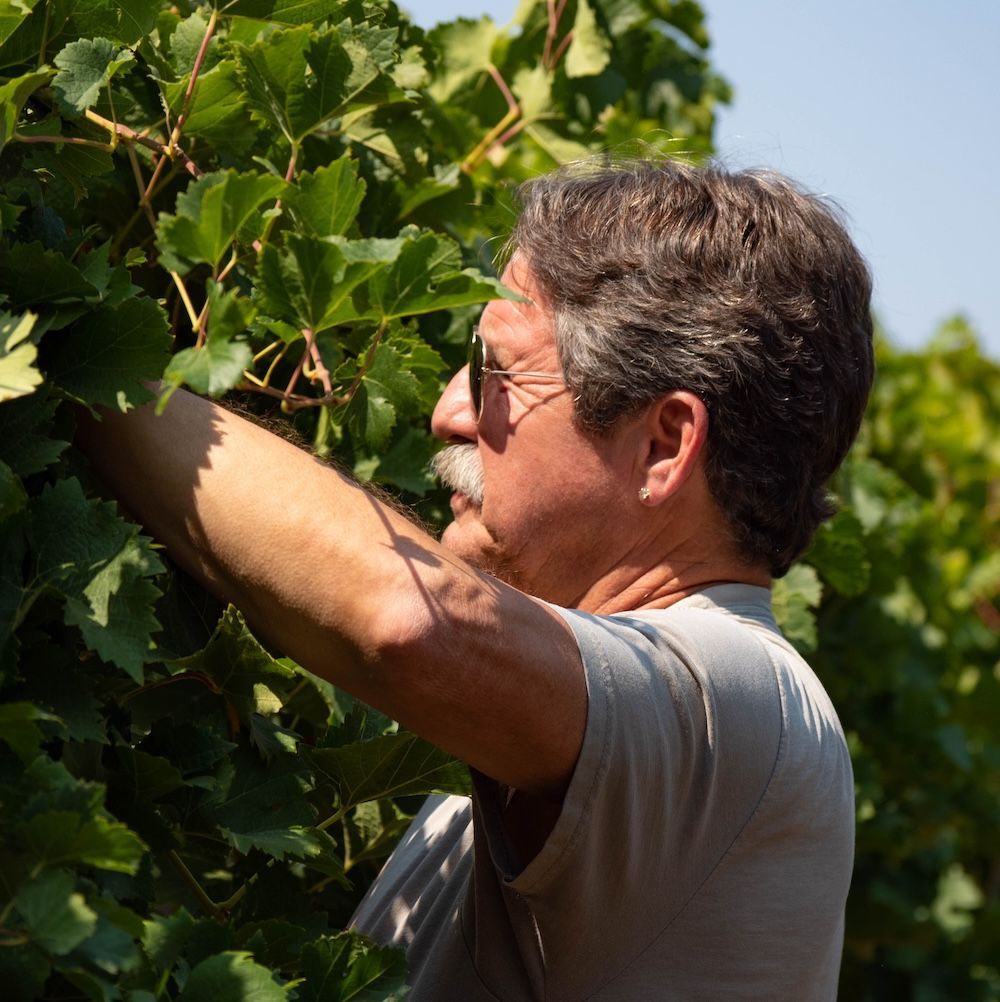
“Merlot has always felt like home to me. There’s a warmth and honesty to it. It’s generous without trying too hard, and it has this way of fitting in no matter the occasion. Up here on Spring Mountain, it takes on a depth that still amazes me after all these years. I'd love to say that’s why we planted it, but the truth is, we just got lucky. But that is why we’ve never let go of it!”
Sheldon Richards, Owner & Winemaker
History & Heritage
With roots in the vineyards of Bordeaux and a legacy that now spans the globe, Merlot carries a history as rich as its flavor. From its early role in France’s great blends to its rise as a varietal wine of distinction, Merlot has long been celebrated for its balance, elegance, and timeless appeal.
The Origins of Merlot: From Bordeaux to the World
Merlot’s story begins in Bordeaux, France, where it became essential to the region’s iconic blends. Valued for its supple texture and ripe fruit, it was the perfect partner to Cabernet Sauvignon—softening edges, rounding tannins, and adding elegance. Over time, Merlot also proved it could stand beautifully on its own, producing plush, age-worthy wines in the Right Bank appellations of Pomerol and Saint-Émilion. From these origins, Merlot spread across the globe, thriving everywhere from Italy to California, and earning its place as one of the most widely planted and beloved red grapes in the world.
Merlot’s Journey to Napa Valley
In California, Merlot found a natural home. The mix of abundant sunshine, cool evenings, and diverse soils gave rise to wines with plush fruit, balanced acidity, and a welcoming character. Arriving in Napa Valley in the mid-20th century, Merlot quickly showed its potential to produce wines of both charm and structure. And while Cabernet Sauvignon often takes the spotlight, Napa Valley Merlot has steadily earned recognition for its depth, complexity, and impressive longevity—offering a style that is both distinct and enduring.
Paloma Vineyard’s Place in Merlot’s Legacy
At Paloma, Spring Mountain Merlot defines who we are. Our high-elevation vineyards yield wines that are rich yet refined, expressive yet balanced. Recognition such as Wine Spectator’s Wine of the Year cemented Paloma’s role in showing the world that Merlot, in the right hands and terroir, can achieve greatness. Today, that commitment continues across three generations, with each vine tended and each vintage crafted as part of a living tradition. The steep slopes and gentler temperatures of Spring Mountain give Merlot its distinct voice here—layered, age-worthy, and unmistakably Paloma. More than a varietal, Merlot has become our legacy: a reflection of the land, the family who has stewarded it for decades, and the community of wine lovers who have embraced it.
A Brief History of Merlot at Paloma

First Merlot Vines Take Root
1983
Jim & Barbara purchased 17 acres of land at the very top of Spring Mountain. After a few years of hard labor clearing, terracing, and planting, 12.5 of those will soon be planted with a mix of Merlot, Cabernet Sauvignon and Syrah.
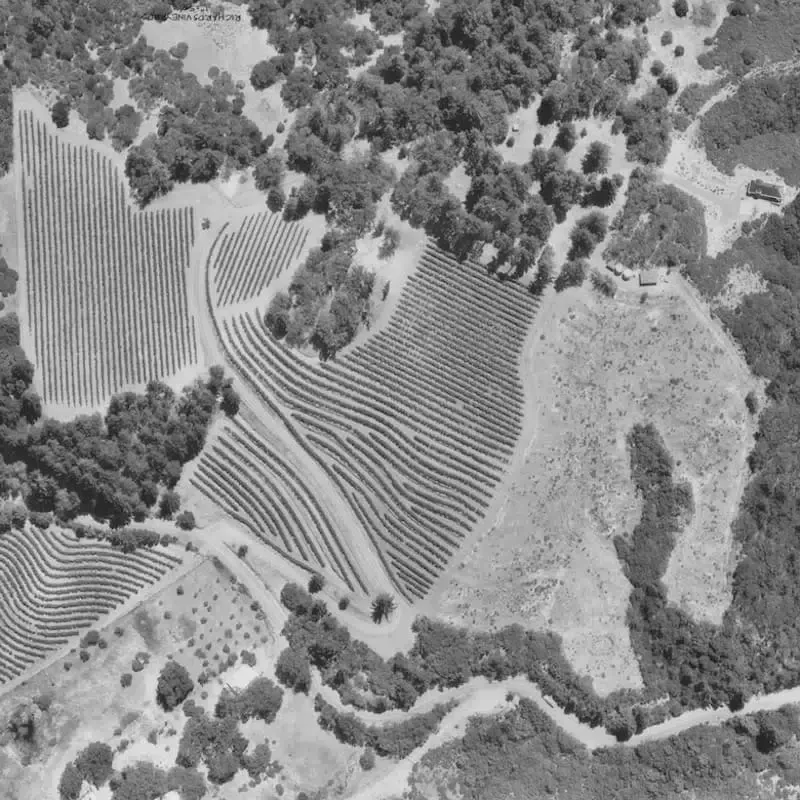

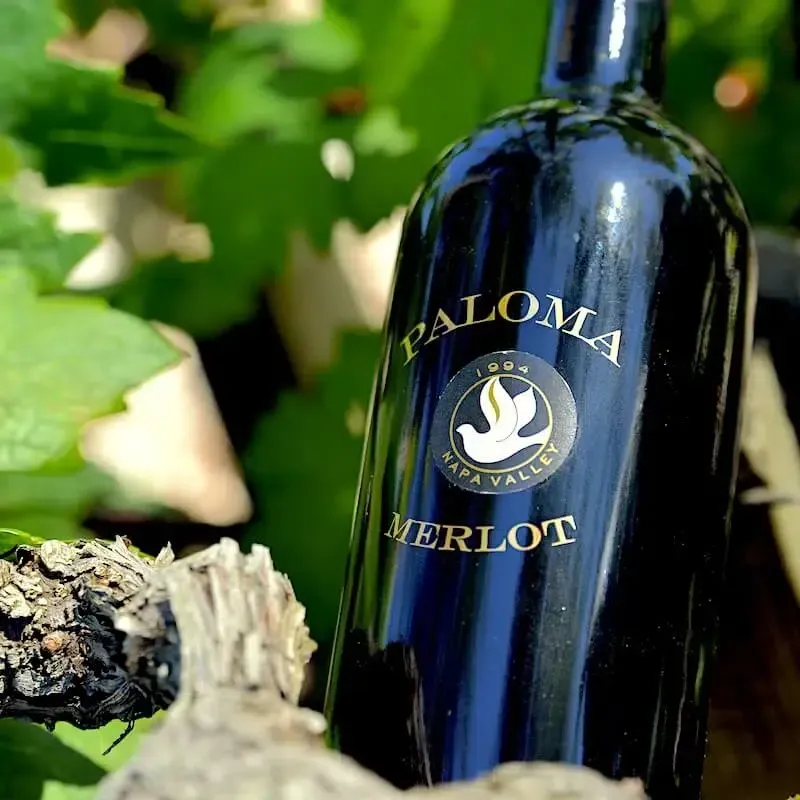
First Vintages
1994
Jim and Barbara make 575 cases of their first vintage of Paloma Merlot. After a decade of living apart to get the business off the ground, they finally built their forever home and made Paloma Vineyard their full-time residence.

Wine Spectator: Wine of the Year
2003
The 2003 edition of Wine Spectator’s “Top 100 Wines in the World” names Paloma’s 2001 Merlot “Wine of the Year“.
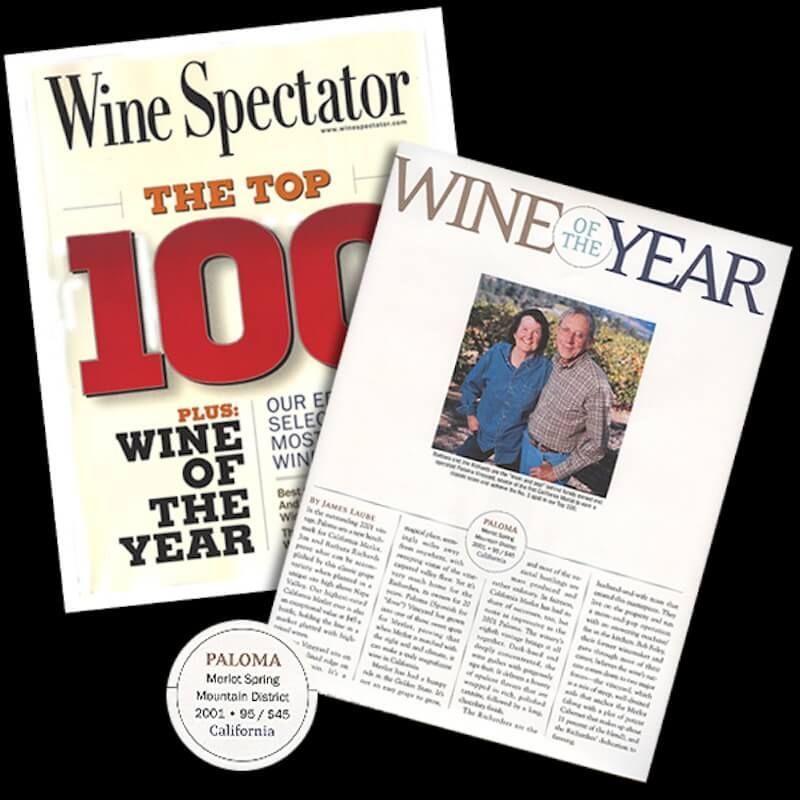

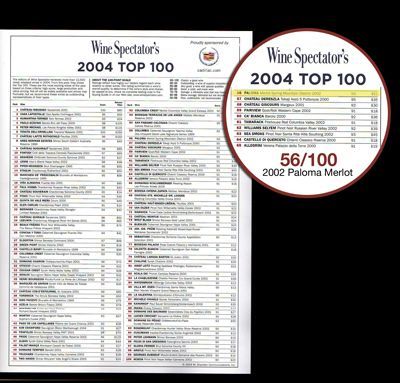
Wine Spectator: Top 100 Wine in the World
2004
In 2004, the 2002 Paloma Merlot was named to the Wine Spectator's "Top 100 Wines in the World" for a second time, at number 56.

Wine Spectator: Top 100 Wine in the World
2009
In 2009, the 2006 Paloma Merlot was named to the Wine Spectator's "Top 100 Wines in the World" for a third time, at number 65.
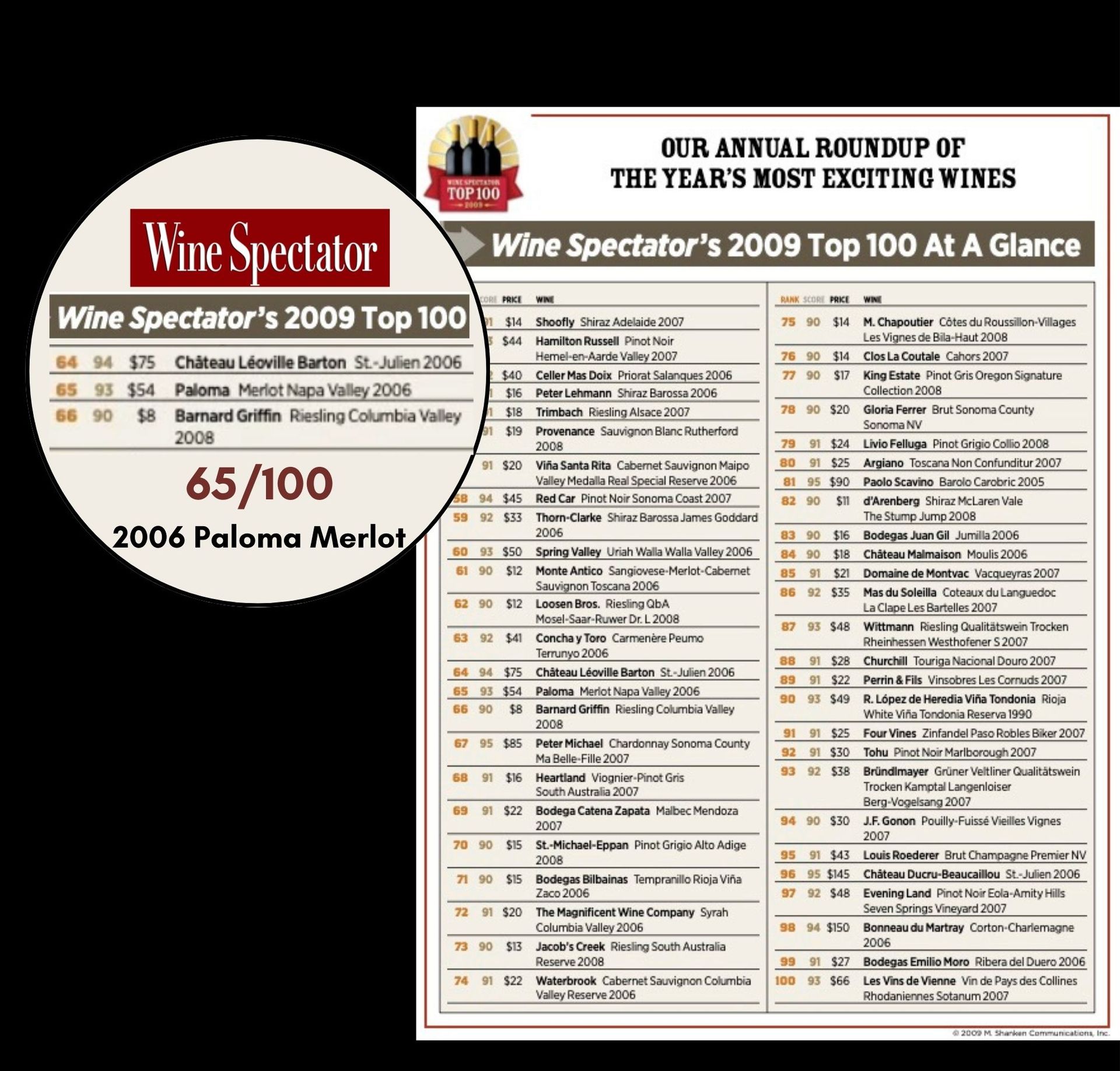


A New Generation of Merlot
2016
Paloma officially passes to the second generation, Jim and Barbara's son, Sheldon Richards who continues to honor and build upon his parents’ remarkable legacy.

A Vintage to Remember, A Vineyard Renewed
2025
The 2021 Paloma Merlot earned 94 points from Wine Spectator—our second-highest score ever, only outdone by the 2001 "Wine of the Year". In the same year, we began the first major replanting of the vineyard in nearly four decades.
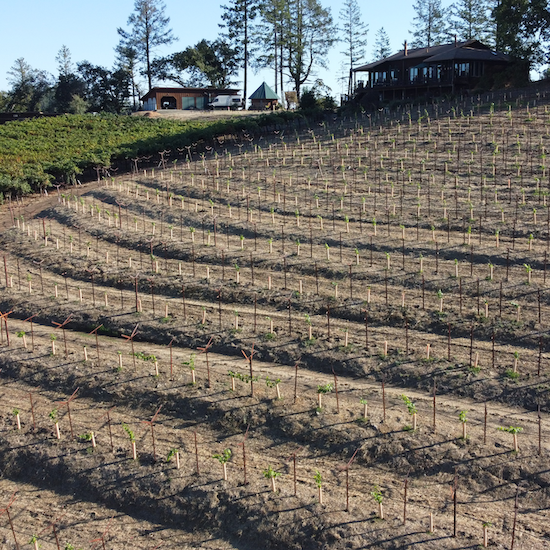
Understanding Merlot
Merlot is one of the world’s great red wines, prized for its plush fruit, supple tannins, and remarkable versatility at the table. In the glass, it bridges power and elegance—ripe berry flavors balanced by structure and depth. Though approachable when young, Merlot also has the ability to age gracefully, developing layers of spice, earth, and complexity over time.
What Makes Merlot Unique?
At its best, Merlot is a shape-shifter: equally at home in a casual glass by the fire or aging gracefully in a cellar. While many associate the grape with plush notes of plum, cherry, and mocha, those flavors are just the start. The real magic lies in Merlot’s adaptability. In cooler climates, it leans earthy and structured; in warmer regions like Spring Mountain, it ripens fully to create rich, layered wines with smooth tannins and immediate appeal. It’s this dynamic personality—fruit-driven yet complex—that keeps Merlot both beloved and deeply misunderstood.
Here on Napa Valley’s Spring Mountain, Merlot takes on an especially expressive character: concentrated yet fresh, with the backbone to cellar and the softness to enjoy today. For Paloma, this grape has never been a supporting role—it’s been the focus from the very beginning, a variety that continues to showcase both the beauty of the land and the craft behind the wine.
Exploring Merlot’s Taste Profiles
Tasting becomes a grounding ritual when approached with presence, curiosity, and a neutral palate—reminding us that appreciation isn’t about perfection, but attention. Merlot, like all great wines, evolves over time. What begins as bold and fruit-forward—bursting with cherry, plum, or spice—matures into a softer, more harmonious expression, where tannins mellow and complexity deepens. Paloma’s commitment to aging—18 months in one third new French oak, followed by years of bottle rest—ensures each vintage reveals its full character when the cork is finally pulled.
Check out these blogs to learn more about Merlot’s flavor profile.
Merlot vs. Other Red Wines: A Gentle Comparison
Merlot’s global appeal lies not only in its smoothness but in its adaptability. Unlike Cabernet’s near-universal planting success, Merlot expresses itself in many clonal forms, allowing winemakers to tailor the grape’s character to specific vineyard conditions. Though both grapes trace their roots to Bordeaux and share Cabernet Franc as a parent, Merlot's softer profile makes it an ideal solo varietal or blending partner to balance bolder reds. While Cabernet excels in the cellar, Merlot shines both young and aged—making it a versatile choice for those seeking easy-drinking elegance without sacrificing depth. Ultimately, Merlot offers a more welcoming introduction to red wine, perfect for both casual drinkers and seasoned collectors alike.
Merlot at Paloma
At Paloma, Merlot isn’t a side note—it’s the focus. While many Napa Valley wineries lean on Cabernet, Paloma built its reputation on Spring Mountain Merlot. From the first vines planted by Jim and Barbara Richards to the three generations farming today, Merlot has always been at the heart of who we are. Lush, aromatic, and beautifully balanced, our wines reflect both the mountain’s unique terroir and the family’s hands-on approach to crafting expressive, enduring Merlot.
Our Winemaking Philosophy: Crafting Merlot with Care
Spring Mountain gives our Merlot its backbone—our high altitude, east facing vineyard provides a unique terroir that brings depth, freshness, and natural balance. From the farm to the cellar, we take a hands-on approach. The goal is never to overshadow the fruit, but to let the character of the mountain and the vintage speak for itself. The result is Merlot that is both structured and graceful, a true reflection of place and craft. High-elevation vineyards on Spring Mountain provide concentration, acidity, and structure. Gentle winemaking and thoughtful oak aging allow the fruit to shine, producing Napa Valley Merlots that reflect both terroir and artistry.
Award-Winning Merlots from the Paloma Estate
Paloma’s dedication has earned international acclaim, including Wine Spectator’s "Wine of the Year" in 2003 for the 2001 vintage, and subsequent Wine Spectator "Top 100 Wine in the World" in both 2004 and 2009. Most recently, the 2021 Merlot received the second highest rating among all Paloma Merlots—second only to the 2001 vintage. Each release continues to prove that Paloma Merlot belongs among the world’s most celebrated wines.
But behind every accolade is the vineyard itself. Farming on the steep slopes of Spring Mountain is demanding work, requiring patience, persistence, and an unwavering commitment to the land. Each vine is tended by hand, every row walked month after month, season after season, because we know that great wines start long before the cellar. That labor of love is what gives Paloma Merlot its depth, balance, and character, and why each release continues to stand among the world’s most celebrated wines.
Enjoying Merlot at Home: Tasting & Pairing
From casual evenings to special dinners, Merlot’s balance and versatility make it a natural companion at home—easy to enjoy on its own and seamless to pair with a wide range of foods.
Tips for Serving Merlot
Merlot shows its best when served slightly cool, around 60–65°F—warmer than a refrigerator, but cooler than most room temperatures. At this range, the fruit shines and the balance of acidity and tannin comes through beautifully. Generally, we also recommend decanting younger vintages for anywhere from 30–60 minutes. This gentle exposure to air allows the wine to open up, softening the structure and releasing its full aromatics—think dark fruit, subtle spice, and a hint of oak. If you don’t have a decanter, even pouring the wine into glasses and letting it rest for a bit can make a noticeable difference.
Cellaring and Aging Potential
While Paloma Merlot is approachable in its youth, it is also built for the long haul. The natural structure from our mountain fruit, combined with careful cellar work, gives these wines the ability to evolve gracefully over decades. In the first few years, you’ll find vibrant fruit and supple texture. With time, those bright flavors give way to layers of spice, tobacco, and earth, gaining depth and nuance with each passing year. Many vintages of Paloma Merlot have shown beautifully at 20–30 years, rewarding those who choose to lay down a few bottles.
Of course, aging wine always carries a bit of risk—sometimes you open a bottle past its peak, and sometimes you catch it at the perfect moment. That unpredictability is part of the fun, and why opening an older bottle can feel like uncovering a little piece of history.
Making Merlot the Centerpiece: Perfect Food Pairings with Paloma Merlot
From easy weeknight dinners to special occasions, Paloma Vineyard Merlot has a way of elevating the table. Its versatility makes it both a welcoming introduction to red wine and a worthy treasure for collectors. With plush fruit, gentle tannins, and balanced structure, Merlot is one of the most food-friendly red wines. Paloma’s Spring Mountain expression shines especially well alongside dishes that highlight its depth and elegance.
Here are four standout pairings that bring our Merlot—and your table—to life:
Duck Breast and Turnips with Medjool Dates
Rich, succulent duck paired with sweet, caramel notes from Medjool dates dances beautifully with the earthy and fruity layers found in Merlot. The wine’s silky mouthfeel mirrors the luxurious reduction in the dish. View Recipe
Potato-Crusted Wild Salmon Filet with Spring Vegetables
This elegant dish, featuring delicate fish topped with a crispy potato crust and seasonal vegetables, pairs wonderfully with the bright acidity and smooth texture of Merlot. The wine’s depth enhances the salmon’s richness without overpowering the dish. View Recipe
Pork Sliders with Tomato Chutney and Grilled Yams
These savory sliders—with their tangy tomato chutney and smoky grilled yams—find a perfect match in Merlot’s fruit-forward profile and gentle acidity. The wine balances the dish’s spice and sweetness, creating a playful yet refined pairing. View Recipe
Spicy Prawn Fettuccine
Seafood meets spice in this creamy pasta, and Merlot steps in as a surprisingly harmonious pairing. Its round mouthfeel and smooth tannins help soften the heat, while its rich fruit notes complement the sauce’s buttery tomato base.
View Recipe




